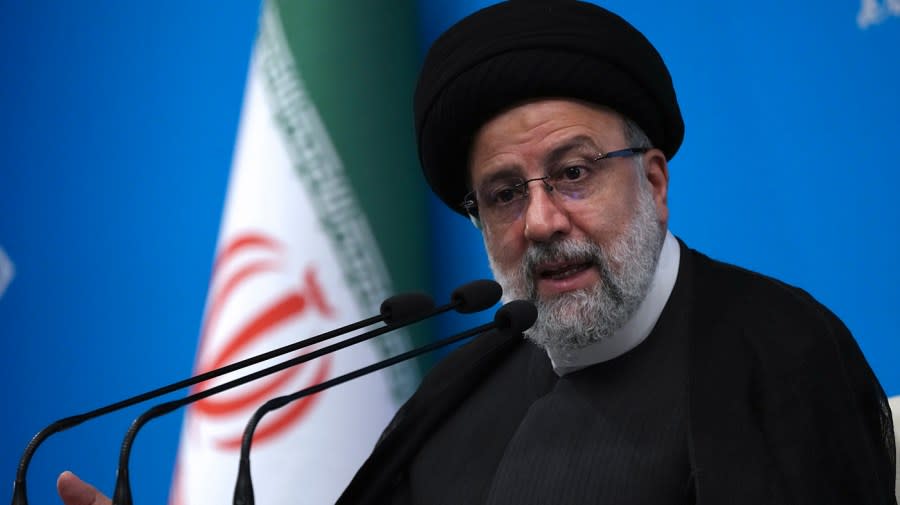How the Iranian president’s death shakes up succession plans

- Oops!Something went wrong.Please try again later.
- Oops!Something went wrong.Please try again later.
Iranian President Ebrahim Raisi’s sudden death has thrown into question who will take the place as Tehran’s next supreme leader.
Raisi, 63, who was killed in a helicopter crash Sunday along with Iran’s foreign minister, Hossein Amir-Abdollahian, was widely considered a leading candidate to take the place of current Islamic Republic Supreme Leader Ayatollah Ali Khamenei, an ailing 85-year-old who has yet to endorse a successor.
Raisi’s death now raises key questions as to who will step into the roles of not just president but the supreme leader as well, raising potential rivalries and injecting instability into a regime that has grown more unpopular in the past several years.
The deaths create “a void in the Islamic Republic’s leadership amid a deepening legitimacy crisis for the Islamic Republic,” Jamal Abdi, president of the National Iranian American Council, said in a statement.
Attempting to tamp down any speculation of political chaos, Khamenei on Sunday wrote on the social platform X that “The nation doesn’t need to be worried or anxious, as the administration of the country will not be disrupted at all.”
And Hadi Tahan Nazif, the spokesperson for Iran’s Guardian Council — a 12-member group that oversees Iran’s elections and legislation — told Iranian state television that “the affairs of the country will not be disrupted.”
Known as the “Butcher of Tehran,” Raisi was well known internationally for leading the brutal 2022 crackdowns on Iranian protesters who were demonstrating against the country’s conservative Islamic theocracy.
In the violent crackdowns that followed, authorities killed more than 500 people and detained more than 22,000 others, according to human rights groups.
Raisi was also involved in the mass execution of more than 5,000 political prisoners in the 1980s.
Handpicked to be president in 2021, Raisi was seen as being groomed to potentially step in as the country’s next supreme leader when Khamenei died or stepped aside.
Following Raisi’s death, Vice President Mohammad Mokhber has been named as acting president, with a new national election to be held within 50 days to elect a permanent replacement.
Under the Iranian Constitution, the vice president, speaker of the parliament, and head of the judiciary — the country’s three branches of government — must arrange for and hold an election.
But the process is seen as controlled by Iran’s hard-line clerical leaders, with popular participation in elections largely on the decline in recent years, according to Abdi.
“Most recently, this spring, the vast majority of Iranian voters stayed home in parliamentary elections where most moderate and reformist candidates were barred from running,” he said.
“The state will now weigh its interest in mobilizing public participation in an unprecedented election at a time of great regional turmoil against its fears of popular challenges to its rule amid domestic unease.”
Top contenders for the next president — and eventually the next supreme leader — include Khamenei’s son, Mojtaba Khamenei, as well as Alireza Arafi, a member of the group in charge of selecting a new supreme leader known as the Assembly of Experts.
“Raisi’s death raises the prospect of renewed jockeying for the position,” Jon Alterman, director of the Middle East program at the Center for Strategic and International Studies, wrote of the situation. “This does not guarantee the rise of the person seen as Raisi’s chief rival for the job, Khamenei’s son Mojtaba. There is deep resistance to the inheritance of power in Iran.”
The vote also comes at a turbulent time for Iran, with a regional conflict with Israel, rising economic struggles and public unrest among Iranian civilians who are unhappy with the regime’s social and political restrictions.
Alterman predicted that the most likely outcome in deciding on Raisi’s replacement “is quiet competition within the state’s coercive apparatus, with elements of the Islamic Revolutionary Guard Corps and military and intelligence figures competing for advantage, and a possible marginalization of clerical leadership in the longer term.”
Such a trend has been underway in Iran for more than a decade, as hostility to the rule of clerics grows among Iran’s young and increasingly impoverished population, he said.
The United States, meanwhile, offered “official condolences” for the deaths of Raisi and Amir-Abdollahian.
“As Iran selects a new president, we reaffirm our support for the Iranian people and their struggle for human rights and fundamental freedoms,” the State Department’s top spokesperson Matthew Miller said in a statement.
Biden administration officials defended the sentiment despite a decades-long adversarial relationship with Tehran, with a recent flare-up after Israel killed several high-ranking Iranian military commanders in Syria. Iran responded by launching more than 300 drones and missiles at Israel, an attack that President Biden had the U.S. military help to thwart.
Following Sunday’s helicopter crash, analysts speculated whether Iran might accuse Israel or the U.S. of politically motivated sabotage, even as initial reports indicated the aircraft crashed due to foggy conditions as it flew through the mountains of northwestern Iran.
But Defense Secretary Lloyd Austin on Monday staunchly denied that the U.S. had anything to do with the accident.
“The United States had no part to play in that crash, that’s a fact plain and simple,” he told reporters at the Pentagon.
Iran’s army chief has since ordered an investigation into the cause of the helicopter crash.
For the latest news, weather, sports, and streaming video, head to The Hill.

